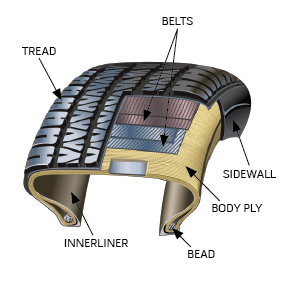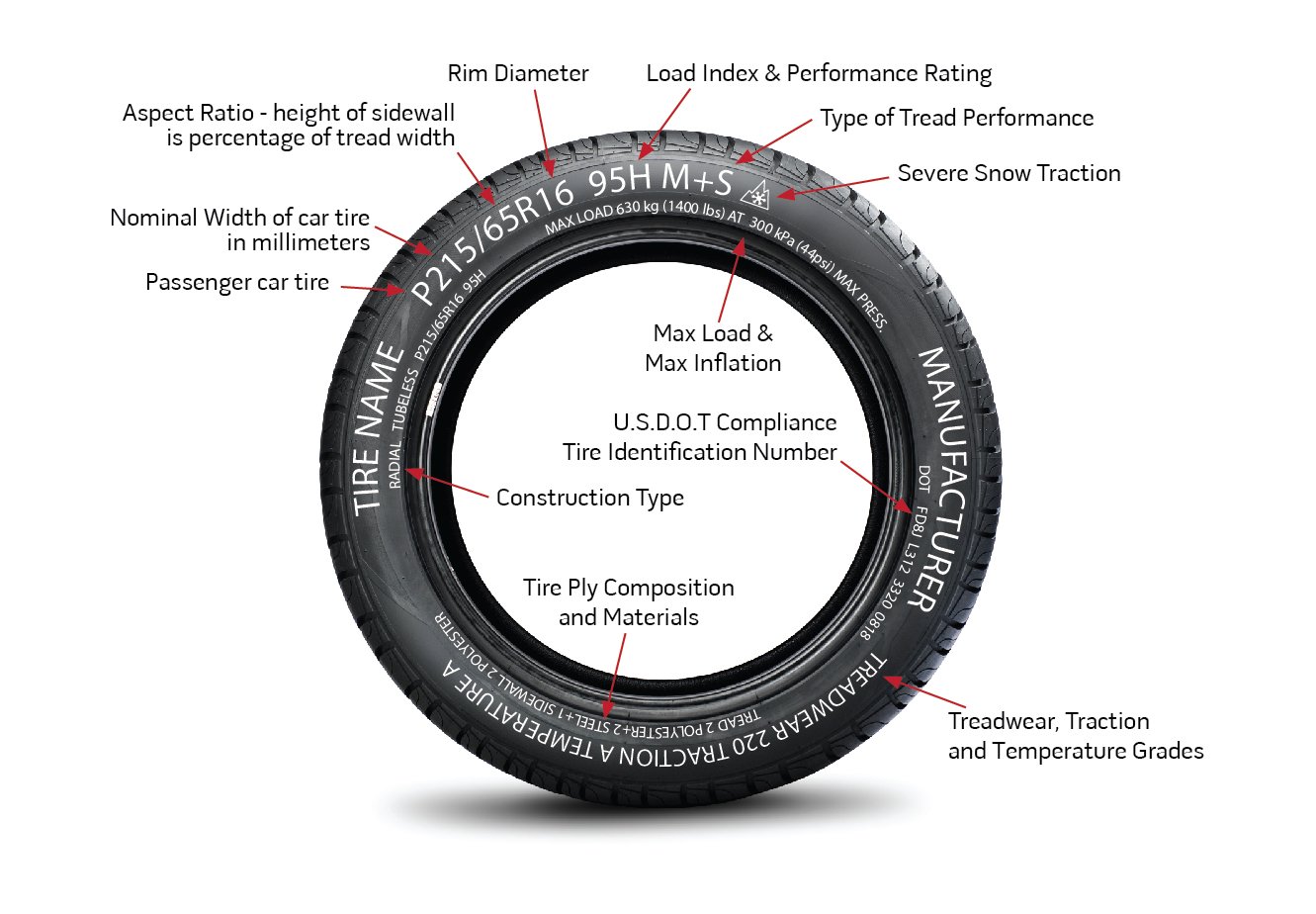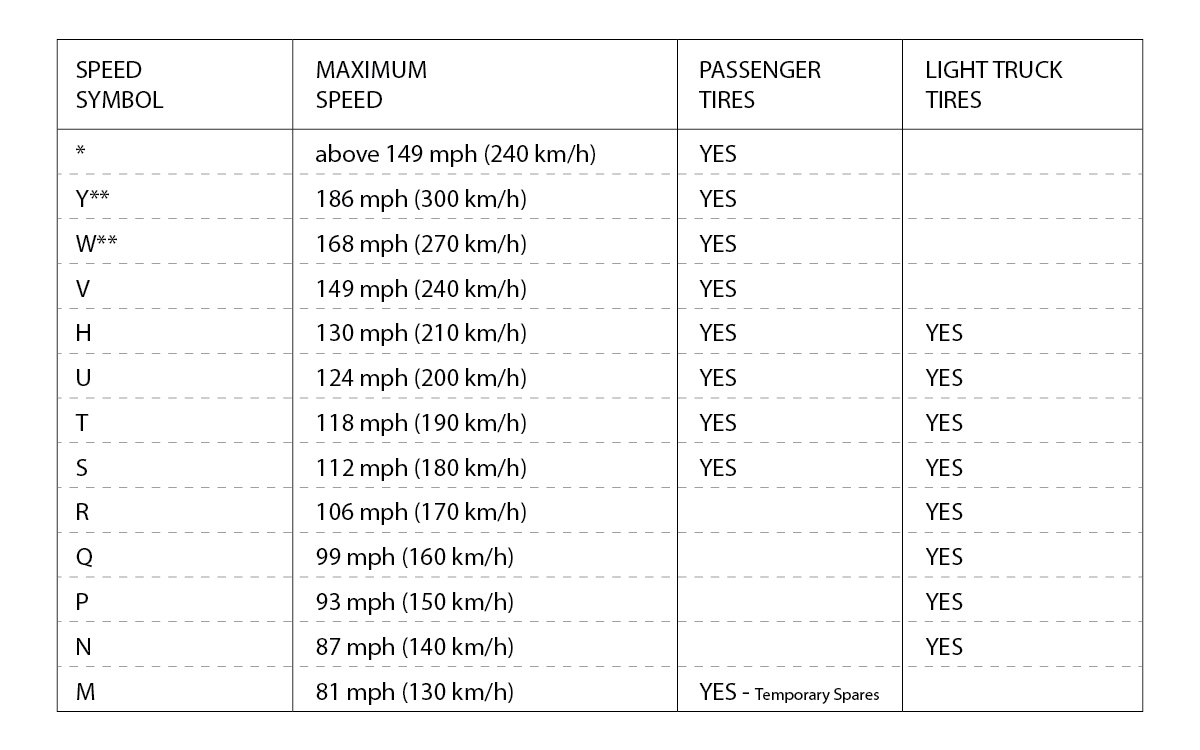Structure of a Tire
Modern tire technology blends a unique mix of chemistry, physics and engineering to give consumers a high degree of comfort, performance, efficiency, reliability and safety. Many tires are custom-designed to meet the stresses and performance needs specified by the maker of a particular model vehicle.
Every tire is carefully inspected, and random samples are pulled for additional safety tests. As part of these tests, tires are x-rayed, cut apart and examined, run on test wheels, or road-tested to evaluate handling, mileage and traction performance.
If properly cared for, tires can last a long time - usually from 40,000 to 80,000 miles, depending on the application.

TREAD: Provides traction and cornering grip.
BELTS: Stabilize and strengthen the tread
SIDEWALL: Protects the side of the tire from road and curb damage
BODY PLY: Gives the tire strength and flexibility
BEAD: Assures and air-tight fit with the wheel
INNERLINER: Keeps air inside the tire
Source: Rubber Manufacturers Association
Tire Sidewall Information
The sidewall of each tire contains useful information about that specific tire. Everything from the name of the tire to the maximum load and any safety information about the tire. All these specs are molded into the sidewall and can be used as a resource for questions you may have about certain details regarding the tire.

The diagram shows where and what information is listed on the sidewall of a popular "P-metric," speed-rated auto tire. "P" stands for passenger; "215" represents the width of the tire in millimeters; "65" is the aspect ratio or ratio of height to width; "R" means radial; "15" is the nominal rim diameter code; and "95 H" is the optional service description that consists of the load index (95) and the speed symbol (H). Some older speed-rated tires may include the speed symbol immediately before the "R" instead of showing a service description.
A "B" in place of the "R" means the tire is belted bias construction. A "D" in place of the "R" means diagonal bias construction. "M+S" with the mountain/snowflake symbol is the designation that the tire meets the RMA (Rubber Manufacturers Association) definitions for use in severe
snow conditions.
The maximum load is shown in kg (kilograms) and in lbs (pounds), and maximum pressure in kPa (kilopascals) and in psi (pounds per square inch). The DOT requires tire manufacturers to grade passenger car tires based on three performance factors: treadwear, traction and temperature resistance. The sidewall also shows the type of cord and number of plies in the sidewall and under the tread.
The letters "DOT" certify compliance with all applicable safety standards established by the Department of Transportation (DOT). Adjacent to this is a tire identification or serial number. This serial number is a code with up to 12 digits that are a combination of numbers and letters. The last characters are numbers identifying the week and year of manufacture. (Example: "1501" means fifteenth week of the year 2001.)
Tire Performance Ratings
Tire performance and speed ratings were originally developed in Europe as a way to assist high performance vehicle owners when choosing replacement tires to match the speed capabilities of their vehicles. Tire performance and speed ratings should never be associated with the ability of the vehicle to handle the speed for which the tire is rated.
P215/65R16 95 H
Today's tires are marked with letters to indicate their speed rating. In the above example, H is the speed rating. Speed ratings are based on laboratory tests which relate to performance on the road. Tires may be marked with one of these speed symbols, M, N, P, Q, R, S, T, U, H, V, W and Y to identify the particular tire's speed rating. Additionally, the letter Z may appear in the size designation (see chart below).
When a replacement of your tires is required, consult the vehicle manual or tire placard for proper size and speed rating (if required). If the vehicle manual placard specifies speed-rated tires, the replacement tires must have the same or higher speed rating to maintain vehicle speed capability. If tires with different speed ratings are mounted on the same vehicle, the tire or tires with the lowest rating will limit the tire-related vehicle speed.
Tire speed ratings do not imply that vehicles can be safely driven at the maximum speed for which the tire is rated, particularly under adverse road and weather conditions, or if the vehicle has unusual characteristics. Never operate a vehicle in an unsafe or unlawful manner.

**A "ZR" may appear in the tire size designation.
NOTE: For "V", "W", or "Y", and tires with a "ZR" rating, a vehicle load adjustment (for speed) is required; consult tire manufacturer.
Source: Rubber Manufacturers Association
